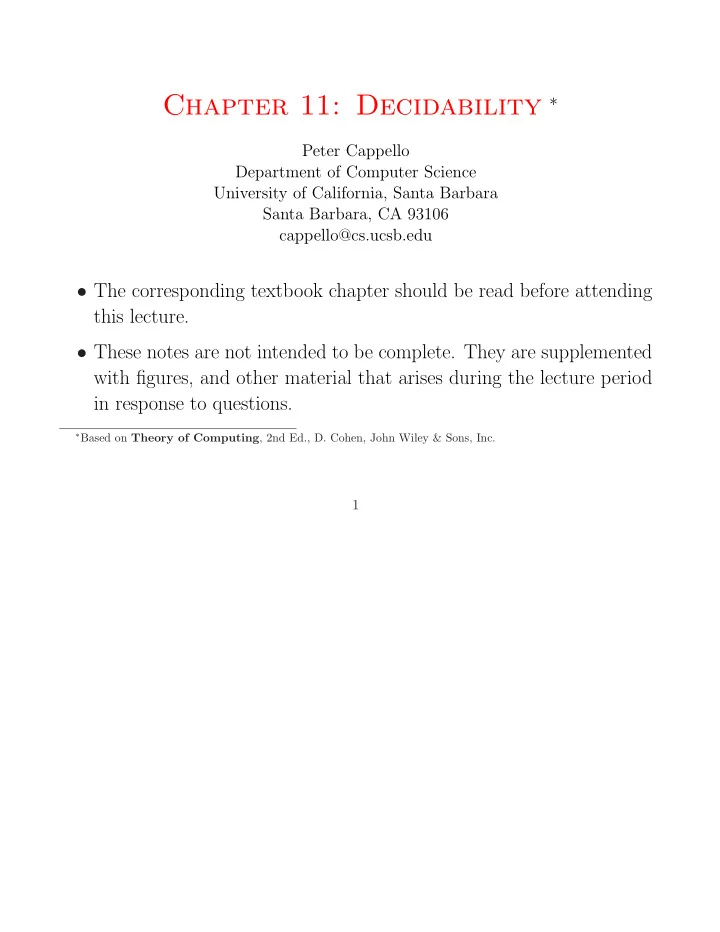

Chapter 11: Decidability ∗ Peter Cappello Department of Computer Science University of California, Santa Barbara Santa Barbara, CA 93106 cappello@cs.ucsb.edu • The corresponding textbook chapter should be read before attending this lecture. • These notes are not intended to be complete. They are supplemented with figures, and other material that arises during the lecture period in response to questions. ∗ Based on Theory of Computing , 2nd Ed., D. Cohen, John Wiley & Sons, Inc. 1
Definitions • A problem is effectively solvable if there is an algorithm for solv- ing it (a procedure that completes after finitely many steps, the max- imum of which is known in advance, but may depend on the size of the input). • A problem whose solution is “yes” or “no” is a decision problem . • An effective solution to a decision problem is a decision procedure . • A decision problem that has a decision procedure is decidable . 2
Theorem: Let A be an FA. The question “Is L ( A ) = ∅ ?” is decidable. Proof : 1. L ( A ) � = ∅ if and only if there is a path from A ’s start state to some final state. 2. The following algorithm returns true if and only if there is a path from A ’s start state to some final state. 3
boolean isEmpty ( FA A ) { paint q 0 blue; set.put ( q 0 ); while ( ! set.isEmpty () ) { p = set.remove (); For each a ∈ Σ, if ( p ′ = δ ( p, a ) is not blue ) { paint p ′ blue; set.put ( p ′ ); } } return ( there is a blue final state ) ? false : true; } 4
Theorem: Let A be an FA with n states. If L ( A ) � = ∅ , A accepts a word w , | w | < n . Proof : 1. The shortest path from A ’s start state to some final state, if any, can be no longer than n − 1: It cannot involve a circuit. 2. The concatenation of arc labels consists of less than n letters. Thus, “Is L ( A ) = ∅ ?” also can be answered by running A on no more than m n − 1 + m n − 2 + · · · + m 0 words, where m = | Σ | . 5
Theorem: Let A and B be FA accepting L A and L B , respectively, and E and F be regular expressions. The following questions are decidable: 1. Is L A = ∅ ? 2. Is L A = L B ? 3. Is E equivalent to F (i.e., do they denote the same language)? Proof : 1. This follows from our previous theorem. 2. L A = L B ⇐ ⇒ ( L A ∩ L B ) ∪ ( L B ∩ L A ) = ∅ . 3. For each regular expression, construct an equivalent FA , using Kleene’s theorem. Use part 2 above to see if these 2 FA accept the same language. 6
Finiteness Theorem: Let R be a regular expression. | L ( R ) | = ∞ ⇐ ⇒ R has a Kleene star that applies to something other than Λ. Proof : 1. If R has no Kleene star operator, it denotes a finite set. 2. Λ ∗ = Λ. 3. If the Kleene star operator is applied to something not equivalent to Λ, the resulting set is infinite. 7
Theorem: Let A be an FA with n states. L ( A ) = ∞ ⇐ ⇒ ∃ w ∈ L ( A ) , n ≤ | w | < 2 n . Proof : 1. If ∃ w ∈ L ( A ) , n ≤ | w | < 2 n , then L ( A ) = ∞ . This follows from the pumping lemma: If there is any word w , | w | ≥ n , then w = xyz , such that xy k z ∈ L ( A ), ∀ k > 0. 2. If L ( A ) = ∞ then ∃ w ∈ L ( A ) , n ≤ | w | < 2 n . (a) By the pumping lemma, ∃ w ∈ L ( A ) , w = xyz , and | xy | ≤ n . (b) Thus, | y | ≤ n . (c) Assume without loss of generality that the part of the accepting path associated with x and z do not contain any loops. (d) xz ∈ L ( A ), and | xz | < n . (e) Let k be the smallest exponent that makes | xy k z | ≥ n . Then, | xy k z | < 2 n . 8
Theorem: Given FA A , the question “Is L ( A ) = ∞ ?” is decidable. Proof : 1. Check each word w , n ≤ | w | < 2 n . 2. If any are accepted, L ( A ) = ∞ ; otherwise, L ( A ) < ∞ . When you study DFS, you should conceive of faster ways to test for finite- ness. However, the proof above, requires only that: • you know how many states the FA has; • you know if w ∈ L ( A ), for any word w . You do not need to be able to examine the FA. 9
Recommend
More recommend